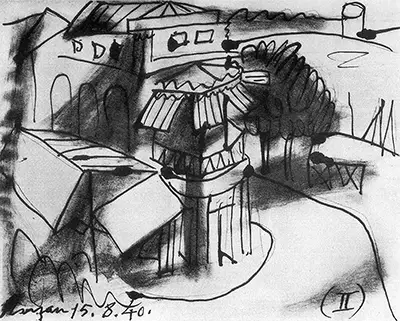In his sketch, Picasso depicts a café in the French resort town of Royan, a popular tourist seaside town along the Atlantic Ocean side of southwestern France.
Parisian artists often visited Royan, considering the area a haven from growing hostilities felt in Paris from the Nazis in the late 1930s and 1940s.
Picasso often visited Royan, visiting a hotel and villa in the area through the 1930s and keeping a full studio on one floor of an oceanfront house.
The views from the house provided influence for several of Picasso's works. Picasso was in Royan in September 1939 at the time of France's declaration of war with Germany.
Following this landmark incident, Picasso returned to Paris to store his artworks in bank vaults, fearing his paintings could be destroyed and hoping to have his touring work kept safe.
Picasso returned to Royan following these protective measures, sketching an painting a Café in Royan among other Royan scenes in 1940.
He settled in Royan after war's declaration, thinking Paris unsafe and vulnerable to bombing. Other artists followed Picasso, giving Royan a distinctive Surrealist population from the 1940s.
As Café in Royan is just a sketch, it was never meant to be widely distributed or exhibited. Instead, it served inspiration for Picasso's paintings and as an indication of his growing interests as preserved in his notebooks. Given the historical context of the period, Picasso's Royan is an attempt to sink back and preserve a care-free lifestyle on the cusp of war, serving a visual antidote to the anxieties felt by Picasso and other artists at the time.
Here, Picasso sketches out a vibrant looking but still and unpopulated cafe among coastal town houses, yacht sails, slanting walkways and a coastline in the background with a lighthouse. It did not take long for war to come to Picasso. The Nazis invaded France in 1940 and marched into an oceanside hotel in Royan in June 1940, two doors away from Picasso.

